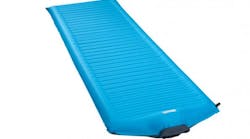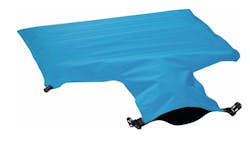The Venturi principle preserves mass flow rate and energy: As fluid flows through an orifice at a steady rate, a sudden reduction in cross-sectional area causes velocity to increase so that mass flow rate can be preserved through a smaller hole. This increase in velocity, or kinetic energy, is accompanied by a drop in static-pressure energy so that energy is conserved.
Thermarest’s Camper SV is responsive to a person blowing into it from about 4 inches away. As the person blows toward the valve, their mouth acts as a venturi, directing air though a small orifice at high speeds and lower pressure than the external environment. As the person’s breath fills the mattress, a pressure gradient builds up between the internal and external environments. The Camper SV continuously responds to this pressure gradient by pulling the higher-pressure ambient air into it until it reaches equilibrium or fills up.
The video below is in French, but it demonstrates the capabilities of the Camper SV:
Like most valves on inflatable mattresses, the Camper SV valve is unidirectional with a release mechanism that can be activated for deflation. The mattress is 3-in. thick, 77-in. long, and is offered in 25-in. wide ($120) or 30-inch wide ($150) varieties.


